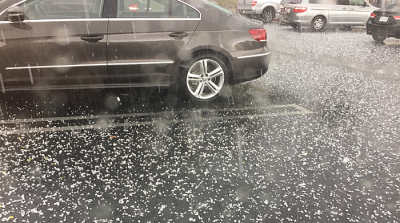Aerosols Notably Contribute to the Predictability of Hail and Precipitation
Hailstorms, a damaging phenomenon found across the world, are difficult to predict, and their response to aerosol change remains largely uncertain. Exploring the aerosol-induced uncertainty in hail and precipitation forecasting has become an increasingly hot research topic. Researchers quantified the uncertainty of hail and precipitation by varying both the cloud condensation nuclei concentration (CCNC) and initial meteorological conditions in Weather Research and Forecasting (WRF) model simulations. They found that varying the CCNC can cause greater uncertainties in hail and precipitation predictions than meteorological perturbations. These results emphasize the importance of considering aerosol effects in severe weather forecasting.
There are increasing concerns in the scientific community about the uncertainty aerosols produce in forecasting hail and precipitation. This is due, in part, to a lack of large ensemble simulations that demonstrate the significance of aerosol effects on weather extremes. This study fills the gap and shows that changing CCNC modifies the predictability of hail and precipitation based on large ensemble simulations, advancing our understanding of hail and precipitation predictability. This provides practical guidance for future forecasting.
Researchers assessed the contribution of aerosols to hail and precipitation predictability by varying both the CCNC and the initial meteorological conditions. They employed the WRF model at 0.5-km grid spacing and performed a large ensemble of cloud‐resolving simulations (1,200) of a hailstorm occurring at Ordos City in the Inner Mongolia Autonomous Region of China. They found that, although meteorological perturbations produce large uncertainties in both hail and total precipitation, varying CCNC by an order of magnitude caused even larger uncertainties. Changing CCNC modifies the predictability of hail and total precipitation. Hail is more predictable in moderately polluted environments compared with very clean and polluted environments. For total precipitation, the predictability is higher in clean environments than polluted environments. Perturbing the initial meteorological conditions does not qualitatively change how aerosols affect hail and total precipitation. Constraining the initial meteorological perturbations helps reduce CCNC-caused uncertainty. These findings solidly support the consideration of aerosol effects in severe weather simulations and forecasting.

